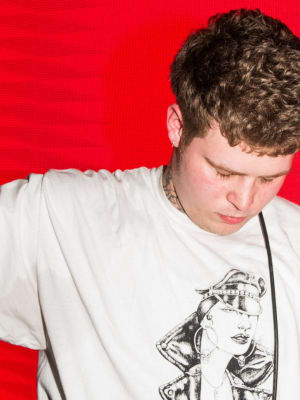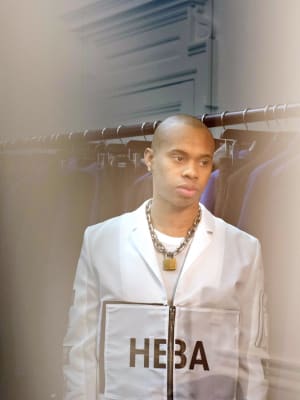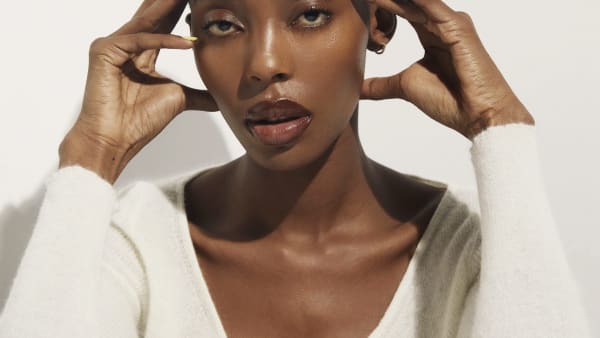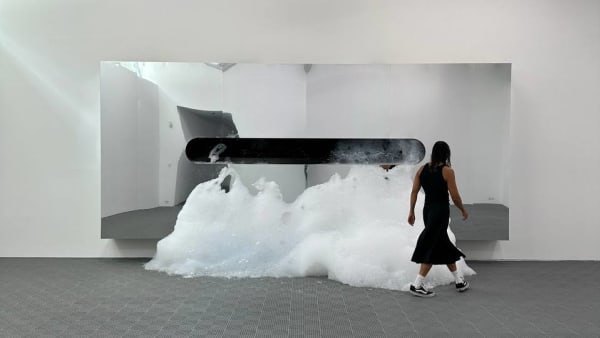
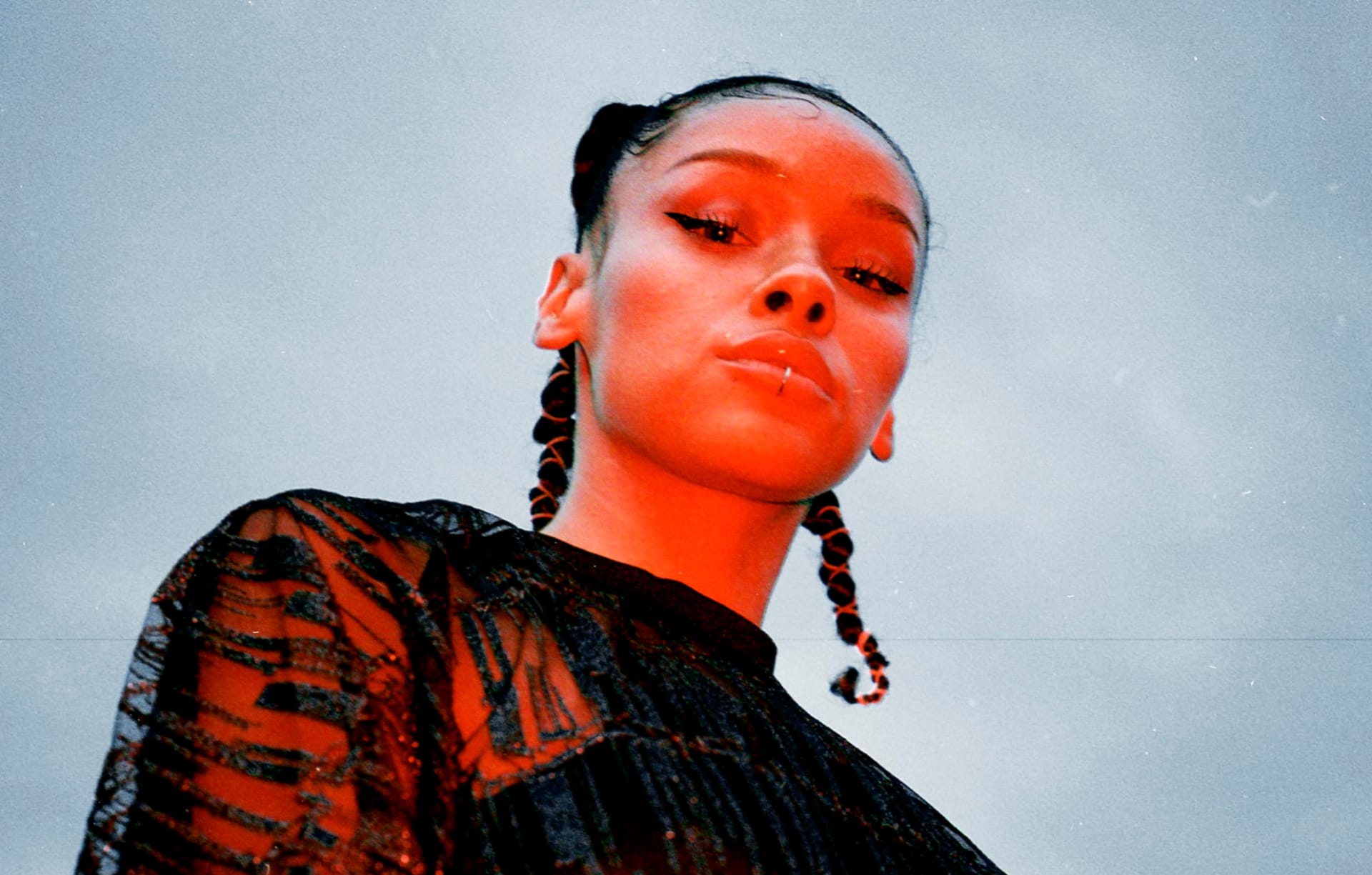
Rekids Affiliate Raven On Embracing Human Imperfection
The Berlin-based producer opts for an unpolished touch across disciplines. “I like to thrift my music just like I like to thrift my clothes,” she says.
Raven’s creative approach is a little rough around the edges, and these minor imperfections are what makes her so special.
At moments, some of the lyrics on her rave-ready track “Saint,” off her debut EP Flames, are distorted, inaudible, and lost in the kick drum, but its siren song still remains. The Vancouver-born, Berlin-based artist isn’t afraid to leave the interpretation up to the listener. This sense of insouciance is also present in her personal style, from the way she’ll redesign secondhand trousers into a strapless bustier with cascading back-ties, to the way she’s able to effortlessly throw together ripped garments and call it a look. “I like to thrift my music just like I like to thrift my clothes,” she says. Within her fashion and her takes on old school techno, acid, and electro, Raven keeps it lo-fi to celebrate the unpolished, unpretentious touch of human error.
In this sense, her music naturally reveals a level of vulnerability, and a willingness to engage the listener in an intimate exchange. Isolated sequences build and collapse on repeat, as all sense of time is lost in their purgatory-like state. The Flames EP, released on Radio Slave’s Rekids label in April, is a five-track dedication to the dancefloor. Each composition is a nod to the Detroit sound, channeling the catharsis of the many early morning raves that Raven experienced in her preliminary days throwing off-location events in Toronto eight years ago.
Raven will be the first to admit that she leads an impermanent life. For the past twelve years, she has been traveling throughout North America and Europe, moving between Barcelona, Berlin, Chicago, Los Angeles, and Mexico City. Yet, while she’s spent a little over a decade throwing herself into new locales, the one thing that has never been transient is Raven’s musical output. In 2011, she stopped off in LA, where she began tapping into her voice through guest vocal appearances and songwriting opportunities, before finding her footing in Chicago two years later. There, Raven spent a minimum of six hours each day fine-tuning her vocals and what would later become her idiosyncratic sound.
Given this peripatetic lifestyle, Raven’s biggest strength is her versatility. During her time living in Toronto, prior to her travels across North America, it was routine to catch her singing on an R&B track in the studio at 5 PM and playing a vigorous techno set at a secret warehouse rave by 2 AM. She’d always felt torn by the divide between these genres, and in 2016, when she began honing her production skills, the barrier between the two sounds dissipated. Raven’s style traverses strict demarcations, too. Drawing from her love of the deconstructions of Berlin-based brand Ottolinger, her older sister’s old school rave aesthetics, and boyish distressed streetwear, she combines all of these disparate influences to generate a look that’s completely her own.




Raven’s interest in the relationship between fashion and music is what made her the ideal ambassador for clubwear brand Together We Dance Alone. On-site at the campaign shoot, the team had the producer’s Flames EP on loop as they let the camera roll, journeying through a series of exclusive club-ready looks that have been under development since the brands’ inception in 2017. The result is the video TWDA x Raven—a collaboration with photographer Bernardo Martins, Together We Dance Alone creative director Ana Ofak and director Carlos Minozzi. “TWDA’s conceptual approach to clubwear is a lot about layering,” Ofak explains, “Peeling off clothes at the club or anywhere else is almost like a performance—performing your body as wrapped in different skins.” Her team tapped Raven for the star role because “we wanted her persona to shine through the layers,” Ofak says, “She owns her style! It is very sartorial, but soft, artisanal, but future femme.”
In the TWDA video, as well as in our interview, Raven shares how, much like her musical output, the style she’s developed over the last ten years is constantly evolving and taking shape depending on her current place in the world.
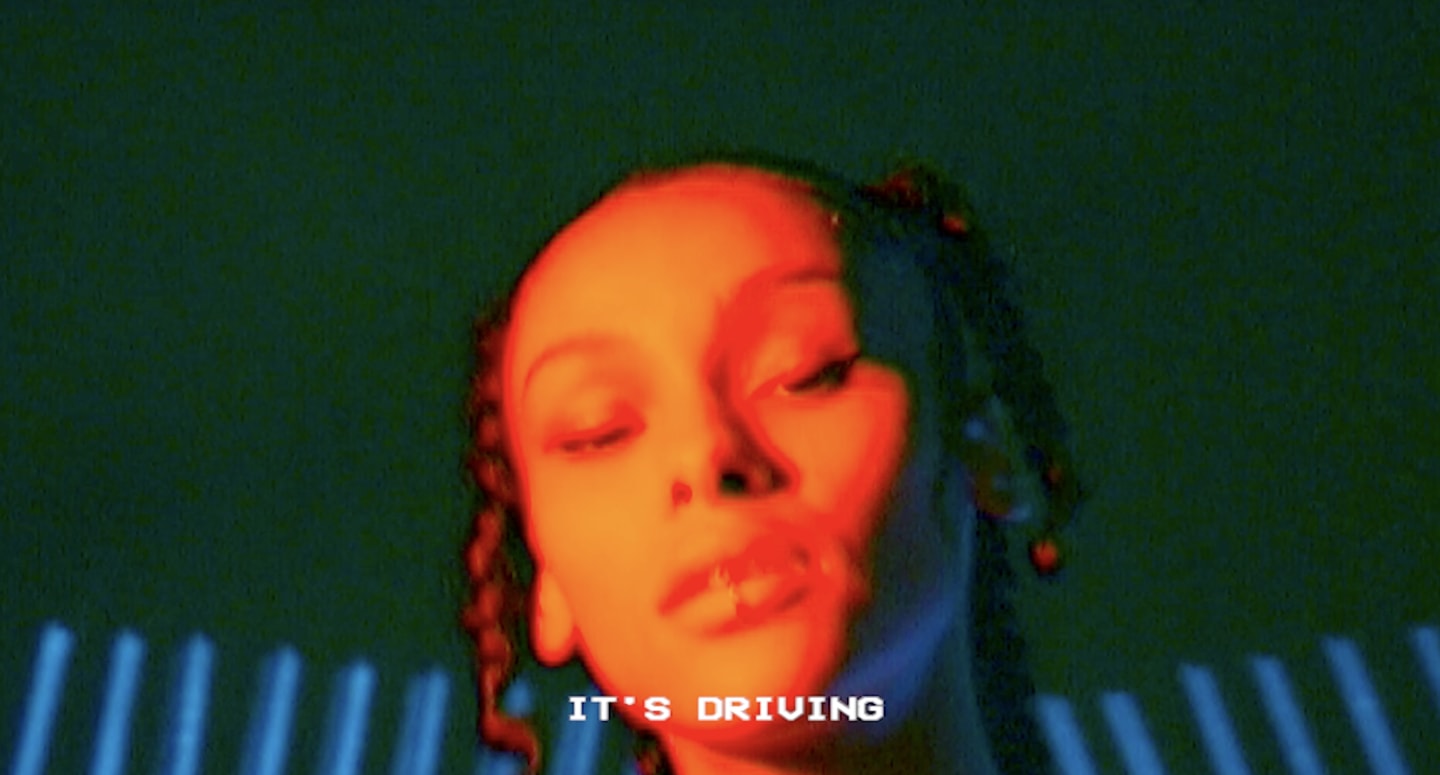
In April, you released your debut EP Flames on Radio Slave’s label ReKids. Can you talk us through your process behind the release? Such as how you translate certain themes via your lyrics.
The majority of the songs on the EP are about relationships and trying to get close to someone to figure them out and how the two of you fit together. I like to explore those deep feelings through my music. The feelings of self-doubt when you’re falling in love with someone and fighting those feelings through the push and pull of being drawn to an individual.
For the lyrics, I like to experiment with free-flow writing inspired by particular themes. Basically, I take a piece of paper and start writing whatever comes into my head and don’t stop until I have a page or so. When I read back over it, if something resonates with me, I’ll challenge myself to turn it into a track, even if it ends up being something completely absurd. I leave a lot of room between the drums and the synth line to save space for the vocals. I use my voice as another instrument on the track and chop it up to see how I can expand upon it.
You describe your music as deep and dark. How do you use your voice to complement and alleviate that sound?
I do like a bit of a darker, melancholic sound. Even the R&B that I was making early on in my career was quite dark; I tap into my ‘sad voice’. Not to sound too emo, but I really like the juxtaposition of techno being so hard, fast, driven, and just in-your-face, and then juxtaposing that with my vocals, which are very warm and tender, gentle even. Even though the things I’m talking about are quite intimate, the track builds this feeling of tension that needs to be relieved through dancing because the vocals are backed by a dance track. You have the urge to dance, but if you listen closely, you might feel a little somber.
At your core, you’re a horror movie enthusiast. Are there any films in particular that you continue to come back to, and do you think that the aesthetics of horror movies influences your music in any way?
I am a big fan of horror movies, 1000%. I watched a cool movie recently, called Piercing. The artwork drew me in, and within the first five minutes, I was hooked because it’s very slow and mirrors real life. You don’t know exactly where it’s going, but it has moments of light and drawn out discomfort. Re-Animator is another classic and favorite of mine.
Do I take any influence from horror movies? Well, I don’t want to sound too creepy! But yeah, I just kind of like things that are a little bit dark, jarring, and disturbing. I’m more drawn to those darker aesthetics and seeing what the boundaries and limits are. When I watch horror movies, it’s interesting to wonder, why do they make us feel uncomfortable? I’m not hugely into lots of gore movies, like Hostel or something; I prefer films that make you feel slightly uncomfortable, like Gaspar Noé’s work.
If I had to liken my music to a horror film, in particular, I’d pick The Ring. There’s a tape labeled “play me,” and then a lady comes through the screen and haunts you once you play it. That’s me, I’m that lady once you listen to my music.
You’re a huge Rick James fan. What is it about him that you admire so much? Are there any other artists that you look to for musical influence?
Rick James didn’t give a fuck. He escaped to Canada, joined a band, and then left Canada to avoid getting drafted into the army. Rick James was always so unapologetically himself and extremely talented. He was also very messy, and I mean, you have to love people that can be that messy, but also have the talent to back it up. Of course, he was an amazing producer and songwriter, and a part of so many hit tracks, but my favorite stuff from Rick James are his ballads. Which are just so unexpected from someone who’s known for “Super Freak” and “Mary Jane.” My favorite track of all time is this song that was never really released, but he performed it live at a festival, there’s footage of it on YouTube. It’s a song called “Big Day.” It’s just such a sad song, and when you watch him perform, you can just see this guy is inside the music, directing the entire performance. You can’t take your eyes off of him. It’s one of those songs that when you’re having a drunk night with a friend, and you’re sharing music, you get “Big Day” up, like, Take this in.
Another one of my favorite artists of all time would be Joey Beltram. He’s exceptionally versatile as a producer, having produced so many different types of music, yet each piece of work sounds like him. Beltram has that iconic signature sound. I’m a huge fan of Belgian new beat too.
I don't like my tracks to be overly-produced or too polished... I feel the same about fashion. I don't like to be too clean. I'm still a little bit rough around the edges.
This element will show content from various video platforms.
If you load this Content, you accept cookies from external Media.
How do you connect your personal style with the visual characteristics of your music to demonstrate the overall feeling of your sound? Do you prefer to DIY things?
I have quite a lot of influences, musically, whether it’s soul, R&B or old-school house or techno. I love to dig back. I’m also very into post-punk music and cold wave, a lot of lo-fi stuff. That lo-fi style really carries over to the music that I make, in the way that I don’t like my tracks to be overly-produced or too polished. I love to hear little discrepancies or mistakes in the vocals.
I feel the same about fashion. I don’t like to be too clean. I’m still a little bit rough around the edges, like, “Okay, this is me—I cut my shirt, and this is what I’m going to wear to the gig.” Or like, “I just made this jacket, stuck some stuff all over it, and now I’m ready to play.”
During the quarantine, I took a lot of my old stuff, which I considered selling, and instead, I transformed it into my next look. I love to wear clothes that look like they’re literally just a ripped piece of fabric that’s been thrown on, tied, and made into a shirt. This is a shirt now; it can also be a skirt next week. Recently I took a t-shirt, and cut it up, discarded the front half, added a halter neck, and then created a tied-up back with strappy pieces of fabric. Another thing I do is if I don’t like a pair of pants, I’ll cut off a leg, so I’m left with a big strip of fabric and then fasten it around my chest and wear it as a top. My friends look at me and go, “Wasn’t that your pants?” and I’m like, “Yeah, now it’s a top!”
Who were your style icons when you were growing up? Who did you look to back then, and who do you follow now?
My style icons were cool girls from Tumblr, and I used to be obsessed with Kesh. She used to be very thrifty and has always been super cool. Right now, I try to see what interesting brands are out there. I keep my eye on Instagram for upcoming designers. At the moment, I really like the label Ottolinger and [Jamie-Maree Shipton], a stylist that goes by @airtomyearth.
Musically, you draw a lot from the early ‘90s rave sound. Did you ever follow the style of those old-school ravers, or have a raver phase yourself?
During her teenage years, my sister was into that whole ’90s raver thing, and I remember she used to have these massive platform shoes that she’d wear to the rave every single weekend. She was definitely a raver, and I always thought that was a super-cool aesthetic. I mean it’s my older sister, so I looked up to her. I’m really intrigued by Goa trance and psytrance. It’s music that’s very emotional, a little bit spiritual, and kind of meditative, but still, dance music at its core. That’s why I love trance music, especially the older stuff. Right now, I think there’s a lot of rave nostalgia going on musically and what I want to recreate is that kind of grassroots feeling. It’s really important for me, when I play, to be part of the community of party people. That, for me, is what raving is really all about. That’s what resonates with me.
Would you say that you have a current personal style, and if so, how did you form that?
There’s been a lot of changes in my style, I’m sure like everybody else. But as I said earlier, I’m a little DIY. I’m DIY in the music I make and in the clothes that I wear. That’s what I liked about Together We Dance Alone. Going back to the raver style that we spoke about: that’s what TWDA is doing by creating clubwear. Clubwear is streetwear in a sense, but TWDA is working on collaborations with MISBHV and other labels to create that link between fashion and the underground music scene. I don’t think there are very many people doing that.
My personal style is a little bit boyish—in the way that I dress and in that I like it when my stuff looks a little ripped and distressed. An outfit usually seems a bit rough, but I’ve usually got nice, fancy shoes on to balance the whole lookout.
How do you prepare yourself before a gig? Do you have a specific routine that you follow, or is there an item that you would put on to get yourself ready for the booth?
I really like the idea of having a lucky shirt or pair of underwear, but honestly, what I realized is that during the time before your set, there’s always something that’s going to go wrong, so I’m over trying to prepare or do anything special in an attempt to combat that. The only thing I try to do is just be like, you know what? I’m going to go out there and have fun. Play what I want to play, look into the crowd, and feel good about it. Feel the energy of the people there with me in that moment. My sets are comprised of around 70% of tracks from 2002 or older, so I get really excited over the opportunity to show the crowd something new and something they may have missed. I like to establish a connection and build the bridge between old and new.
Claire Mouchemore is a freelance writer and radio presenter based in Berlin. She has written for Boiler Room, CRACK, i-D and RA, and is currently the digital editor of Borshch Magazine. Find her on Instagram.
Together We Dance Alone credits—
Director: Carlos Minozzi
Second camera: Julie Maillard
Photographer: Bernardo Martins
Creative director: Ana Ofak
Published October 09, 2020. Words by Claire Mouchemore, photos by Bernardo Martins.

